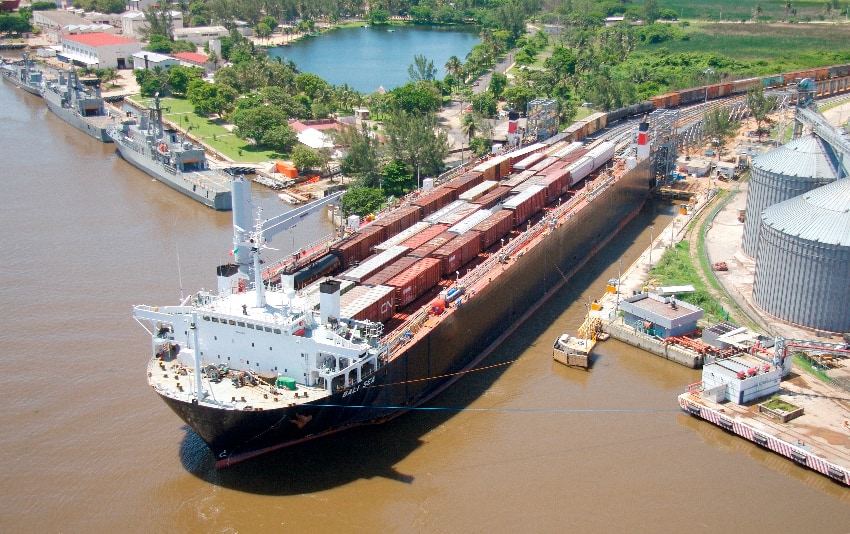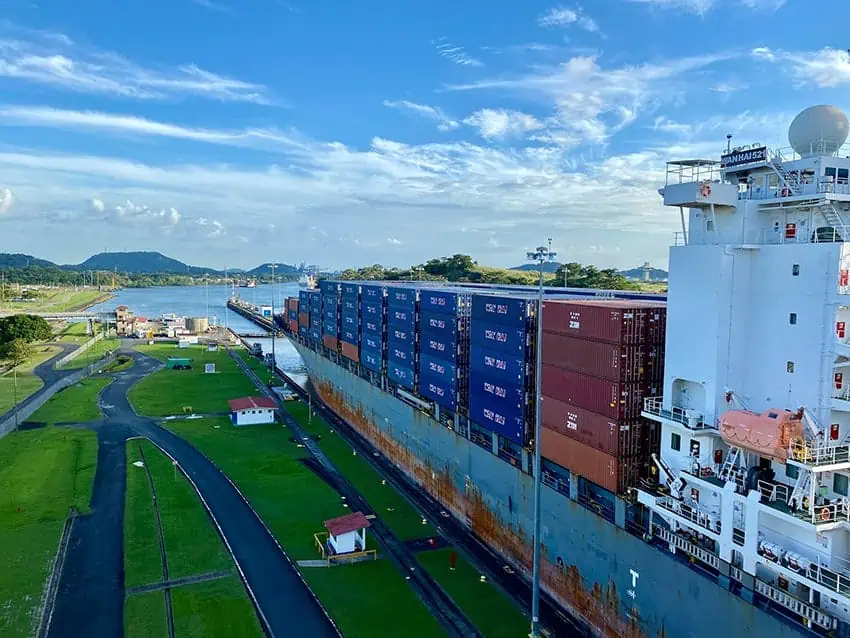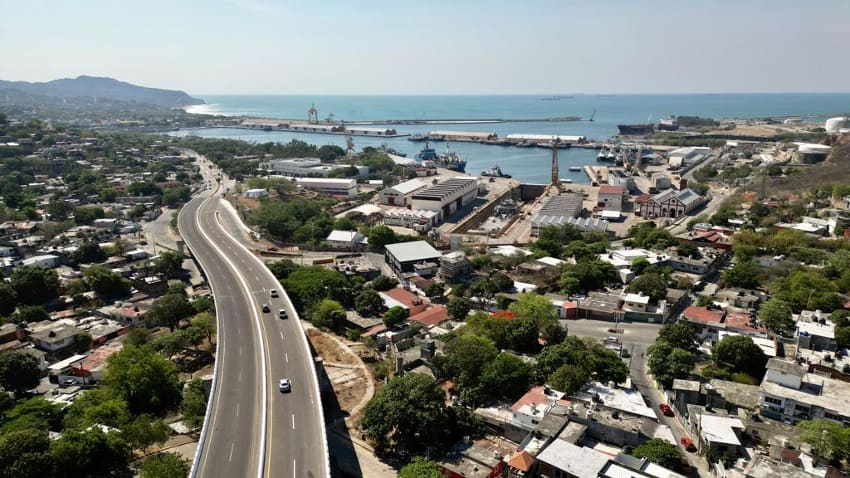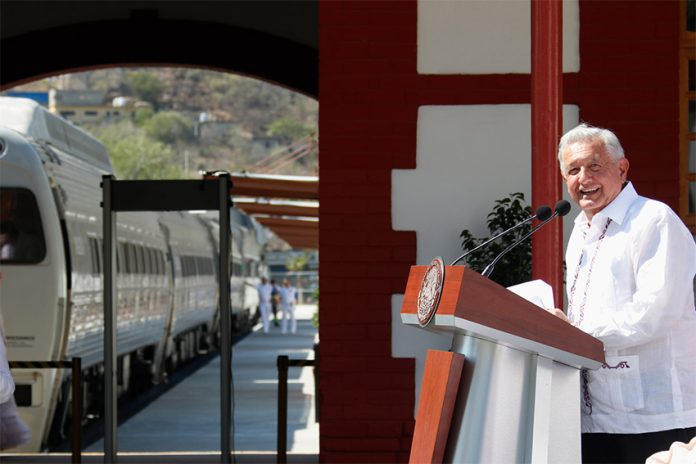A week after the Maya Train began running between Campeche and Cancún, a modernized railroad linking the Pacific and Gulf of Mexico coasts across the Isthmus of Tehuantepec began operations on Friday.
President López Obrador inaugurated the Interoceanic Railroad between Salina Cruz, Oaxaca, and Coatzacoalcos, Veracrauz, at an event in the former city attended by various Mexican officials, U.S. Ambassador to Mexico Ken Salazar, billionaire businessman Carlos Slim and others.
“Authorities, kings, politicians and rulers have been dreaming” about connecting the two oceans for “centuries,” López Obrador said.
The railroad is the centerpiece of the US $2.8 billion Interoceanic Corridor of the Isthmus of Tehuantepec (CIIT), a government project that also includes the expansion of the ports in Salina Cruz and Coatzacoalcos, highway upgrades and the establishment of 10 industrial parks, among other initiatives.
Both passenger and freight trains will operate between Salina Cruz and Coatzacoalcos.
The government is touting the corridor as an alternative to the Panama Canal given that it will connect the Pacific and Atlantic oceans across a relatively narrow strip of land.

Freight shipped from Asia, for example, could be unloaded in Salina Cruz and put on a train for a journey of approximately 300 kilometers to Coatzacoalcos. It could then be reloaded onto another ship before continuing on to the Gulf or Atlantic coasts of the United States.
Navy Minister José Rafael Ojeda Durán said in June that Mexico will become a “world shipping power” thanks to the construction of the trade corridor, but analysts, Reuters reported, “estimate the rail line will be able to ship just a fraction of what the [Panama] canal moves.”
On Friday, López Obrador asserted that “all the Asian countries are very interested” in using the new railroad to move freight “because Panama is at capacity.”
The approximately 80-kilometer-long Panama Canal has been affected by drought this year, leaving it without enough water to raise and lower ships and “forcing officials to slash the number of vessels they allow through,” according to The New York Times.

López Obrador on Friday once again confirmed that the navy will take charge of the CIIT.
“All these [infrastructure] projects are being built with money from the budget, which is the people’s money. We’re just the managers of the people’s money … and we have to leave all these projects in safe custody so we’ve decided that the Ministry of the Navy will take charge of the comprehensive isthmus project,” he said before boarding the train shortly after midday for what was expected to be an eight-hour trip to Coatzacoalcos.
How much are tickets for the trans-isthmus trip?
Trains providing passenger services across the Isthmus of Tehuantepec have three classes: tourist (turista), executive (ejecutivo) and managerial (gerencial).
The price of tickets is calculated depending on the distance a passenger wants to travel.
Completing the entire trip between Salina Cruz and Coatzacoalcos, or vice versa, costs 457 pesos (about US $27) in tourist class, 608 pesos (about US $36) in executive class and 1,554 pesos (about US $91) in managerial, or first, class.
The level of comfort and the availability of amenities vary depending on the class. Travel time is expected to be shorter than the eight hours scheduled for Friday’s inaugural run.
Tickets are available for purchase on the Interoceanic Railroad website and at the 10 stations. Tickets for services this year have already sold out.
How many stations does the railroad have?

There are a total of 10 stations along the railroad, which runs just over 300 kilometers between Salina Cruz and Coatzacoalcos, the two terminuses. The eight other stations are:
- Ixtepec
- Chivela
- Matías Romero
- Mogoñé
- Donají
- Jesús Carranza
- Medias Aguas
- Jáltipan de Morelos
What is the passenger and freight capacity of trans-isthmus trains?
According to information presented by the government on Friday, passenger trains will have the capacity to transport approximately 400 people.
Freight trains, which will start running on the railroad at a later date, will have the capacity to move 5,200 tonnes of cargo in 65 railcars.
Project is for “the new generations,” AMLO says
López Obrador asserted that the opening of the railroad marks the commencement of a “new stage” in Mexico before remarking that “it’s not for our generation, or not just for our generation.”
“… We’re on the way out … but we need to leave a future with possibilities of development for the new generations, we have to think of those coming behind us. This project is for them,” he said.
López Obrador noted that the original trans-isthmus railroad opened in 1907, during the presidency of Porfirio Díaz.

The Panama Canal opened seven years later in 1914 and “became the most important passage” for the movement of freight from the Pacific to the Atlantic, or vice versa, he said.
Due to the growth in trade with Asia, “another passage” is “essential,” López Obrador said.
The president has long asserted that his government’s infrastructure projects in the south and southeast of the country, including the CIIT, the Maya Train railroad and the new Pemex refinery in Tabasco, will help spur economic development in a historically disadvantaged region.
Railroad also for “the communities through which the train passes”
López Obrador acknowledged there has been opposition to the project and said that the government reached agreements with residents who had to vacate their homes due to the construction of stations and the resumption of train services across the isthmus.
“There were places where the tracks had been invaded, alternatives were given to those who lived close [to the railroad],” he said.
“This is a project for the communities through which the train passes, we’re going to continue helping them,” López Obrador added.
More train lines to open in 2024
Two additional railroads that will connect with the Salina Cruz-Coatzacoalcos line (known as Line Z) will open next year.

A 328-kilometer-long section of the FA Line between Coatzacoalcos and Palenque, Chiapas, is scheduled to begin operations next June, according to Raymundo Morales, director of the Interoceanic Train project.
That line will connect with Section 1 of the Maya Train railroad, which runs between Palenque and Escárcega, Campeche. The FA Line will also connect Coatzacoalcos to Dos Bocas, Tabasco, where Pemex’s new oil refinery is located.
The 476-kilometer-long K Line between Ciudad Ixtepec, Oaxaca — a city about 60 kilometers north of Salina Cruz — and Ciudad Hidalgo, Chiapas, on the border with Guatemala, is scheduled to open in the final quarter of next year.
The opening dates for the two lines announced by Morales on Friday are later than ones cited by López Obrador in September.
The president is an avowed train enthusiast, and would like to see a revitalization of Mexico’s once extensive passenger train network.
Last month, he published a decree that established the provision of passenger train services as a priority for national development, taking a first step toward achieving his goal of restoring Mexico’s passenger train network to its former glory.
With reports from El País, Milenio, Reforma, El Financiero and Reuters
